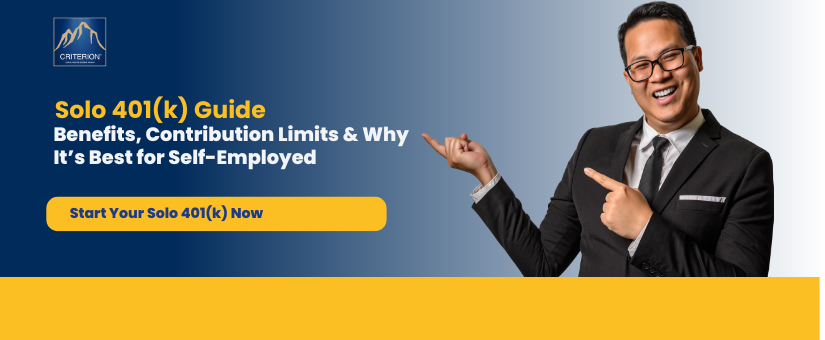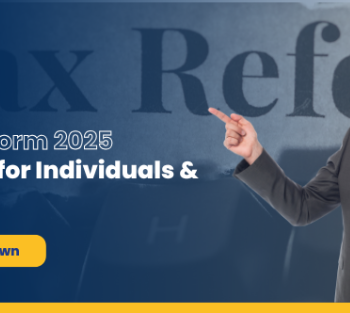
Solo 401(k): Benefits, Contribution Limits, and Why It’s the Best Retirement Plan for Self-Employed Professionals
- On March 19, 2025
Solo 401(k): Benefits, Contribution Limits, and Why It’s the Best Retirement Plan for Self-Employed Professionals
Introduction
If you’re self-employed or a small business owner without employees, securing your financial future can feel overwhelming. Unlike traditional employer-sponsored retirement plans, which are widely available to salaried workers, self-employed individuals often struggle to find the right option. That’s where the Solo 401(k) comes in—an ultimate wealth-building tool designed specifically for entrepreneurs and freelancers.
A Solo 401(k) offers a high solo 401k contribution limit, allowing you to save more for retirement compared to other plans like SEP IRAs. It also provides tax advantages, helping you reduce taxable income while growing your retirement savings. Plus, with a self-directed Solo 401(k), you gain control over your investment choices, from stocks and bonds to real estate and alternative assets.
In this guide, we’ll cover everything you need to know about the Solo 401k, including its benefits, contribution limits, and how to set it up. We’ll also compare it to other retirement plans, such as SEP IRAs, and provide expert strategies for maximizing your tax savings and investment growth.
For self-employed professionals looking to optimize their tax strategy and retirement savings, our Tax Planning Services offer expert guidance tailored to your financial needs. Whether you’re looking to reduce tax liability, improve cash flow, or plan for long-term wealth, our team can help.
Start building your financial future today with a Solo 401k plan is the best retirement plan for self-employed professionals!
What is a Solo 401(k)?
A Solo 401(k) (also called an Individual 401k plan or Self-Employed 401(k)) is a powerful retirement plan designed for self-employed individuals or business owners without employees, except for a spouse.
Key Benefits:
- Higher Contribution Limits: Contribute more than an IRA or SEP IRA, maximizing retirement savings.
- Tax Advantages: Choose between Traditional (tax-deferred) or Roth (tax-free growth) options.
- Diverse Investment Choices: Invest in stocks, ETFs, real estate, and more for greater flexibility.
- Loan Option: Borrow from your retirement funds if needed.
- Simple Setup: Easily establish a Solo 401(k) through financial institutions or online providers.
Proper financial management is essential when handling contributions and tax benefits. Our Bookkeeping Services ensure your finances are well-organized, allowing you to focus on growing your wealth.
-
Higher Contribution Limits
A major advantage of the Solo 401(k) is its generous contribution limits compared to other retirement plans.
For 2024, the Solo 401(k) contribution limits are:
- Employee Contribution: Up to $23,000 (or $30,500 if age 50+)
- Employer Contribution: Up to 25% of compensation (or net self-employment income)
- Total Maximum Contribution: $69,000 (or $76,500 for those 50+)
This is significantly higher than the contribution limits for a traditional IRA ($7,000) or SEP IRA ($69,000 but without an employee deferral option). Higher contributions mean greater tax savings and faster retirement growth. Need professional CPA guidance? Our CPA Consultation is here to help.
-
Tax Benefits
You can choose between Traditional and Roth Solo 401(k) accounts, giving you control over how your retirement savings are taxed:
- Traditional Solo 401(k): Contributions reduce your taxable income, and funds grow tax-deferred until withdrawal. This is ideal for those who anticipate a lower tax rate in retirement.
- Roth Solo 401(k): Contributions are made with after-tax dollars, but withdrawals are tax-free in retirement. If you expect to be in a higher tax bracket later, this can be a strategic move.
Additionally, tax credits and deductions may be available for setting up a Solo 401(k). For effective tax-saving strategies, consult our Tax Planning Experts.
-
More Investment Flexibility
A Self-Directed Solo 401(k) allows you to invest in a wide range of assets beyond just stocks and bonds, including:
- Stocks, bonds, and mutual funds
- ETFs and index funds
- Real estate (rental properties, REITs, etc.)
- Cryptocurrencies and alternative assets
This level of investment flexibility is a key benefit over traditional employer-sponsored plans, which often limit investment options. If you want to optimize your financial records while investing, check out our Bookkeeping Services.
-
Loan Options
Unlike an IRA, a Solo 401(k) allows you to borrow from your plan, providing an additional financial safety net. You can take out a loan of up to $50,000 or 50% of your balance (whichever is lower) to cover business expenses, personal emergencies, or investment opportunities.
Repaying the loan ensures the money stays in your retirement account rather than being subject to early withdrawal penalties. Need financing for your business? Explore our Business Financing Solutions.
-
Easier Administration
Solo 401(k) plans are designed with self-employed individuals in mind, making them simpler to manage. Unlike traditional individual 401k plans, which have extensive reporting requirements and compliance hurdles, Solo 401(k) plans typically require minimal paperwork.
For accounts with a balance of less than $250,000, no annual IRS filing is required. However, once your balance exceeds this threshold, you must file Form 5500-EZ. Managing a Solo 401(k) is straightforward, but if you need professional assistance, our experienced CPAs in Houston are here to help.
How to Set Up a Solo 401(k)
Setting up a Solo 401(k) is simpler than many self-employed individuals realize. Follow this step-by-step guide to get started:
Step 1: Select Your Plan Type (Traditional vs. Roth)
Decide between a Traditional Solo 401(k) (tax-deferred contributions with taxable withdrawals) or a Roth Solo 401k (after-tax contributions with tax-free withdrawals in retirement). The best choice depends on your current and future tax strategy.
Step 2: Complete Plan Documentation
Your provider will require essential paperwork, such as an Adoption Agreement and Plan Document, to establish your Solo 401(k). Ensure all forms are completed correctly to avoid delays.
Step 3: Fund Your Account
Contributions can be made in two ways:
- Employee Contributions: Up to $23,000 (or $30,500 if you’re 50 or older)
- Employer Contributions: Up to 25% of compensation, with a total maximum contribution of $69,000 (or $76,500 for those 50+)
Step 4: Start Investing
Once funded, you can invest in a range of assets, including stocks, ETFs, mutual funds, and alternative investments. Need expert guidance? Our tax consultants in Houston can help with tax-efficient investment strategies.
Solo 401(k) vs. SEP IRA: Which One is Better?
Both Solo 401(k) and SEP IRA plans offer excellent retirement benefits for self-employed individuals, but they have key differences:
| Feature | Solo 401(k) | SEP IRA |
| Contribution Limit | Up to $69,000 | Up to $69,000 |
| Employee Contributions | Yes | No |
| Roth Option | Yes | No |
| Loan Option | Yes | No |
| Investment Flexibility | High | Moderate |
Which One Should You Choose?
- Solo 401(k): Ideal if you want higher tax advantages, Roth options, and loan access.
- SEP IRA: Suitable for those who prefer simpler administration but with fewer contribution options.
Not sure which plan is right for you? Our CPA Firm provides expert retirement planning solutions tailored to your needs.
Common Mistakes to Avoid When Using a Solo 401(k)
A Solo 401(k) is a powerful retirement savings tool for self-employed individuals and small business owners. However, mismanaging your plan can lead to missed opportunities and financial setbacks. Here are some common mistakes to avoid when using a Solo 401(k):
1. Not Maximizing Contributions
One of the biggest mistakes self-employed individuals make is not taking full advantage of the high 401k contribution limits available with a Solo 401(k). Unlike traditional IRAs, a Solo 401(k) allows both employer and employee contributions, significantly increasing the total amount you can save each year. By not maximizing contributions, you leave potential tax savings and long-term investment growth on the table. Utilizing Tax Planning Services can help you optimize your contributions and ensure you’re making the most of your retirement plan.
2. Ignoring the Roth Solo 401(k) Option
While many business owners focus on the traditional Solo 401(k) for its immediate tax benefits, the Roth Solo 401(k) offers tax-free withdrawals in retirement. If you expect to be in a higher tax bracket in the future, contributing to a roth 401k can provide significant tax advantages. Balancing both traditional and Roth contributions can create a tax-efficient retirement strategy.
3. Failing to File Form 5500-EZ
If your Solo 401(k) balance exceeds $250,000, you are required to file Form 5500-EZ annually with the IRS. Many self-employed individuals overlook this requirement, leading to unnecessary penalties. Staying compliant with IRS regulations is crucial to avoid fines and maintain the benefits of your retirement plan. Seeking guidance from a CPA Firm can ensure you meet all filing requirements and avoid costly mistakes.
4. Not Diversifying Investments
Many Solo 401(k) account holders concentrate their investments in a single asset class, such as stocks, without considering diversification. A well-diversified portfolio—including real estate, bonds, ETFs, and alternative investments—can help mitigate risk and enhance returns over time. If you need financing for real estate or business investments, Business Financing services can assist in structuring your financial strategy.
5. Overlooking Professional Tax Planning
Tax efficiency is key when managing a Solo 401(k). Many business owners fail to integrate their retirement contributions with overall tax strategies, missing out on significant deductions and benefits. Proper tax planning can optimize your contributions and maximize your savings. Consulting with a CPA Firm for expert tax advice can ensure you are leveraging all available tax advantages while staying compliant with IRS rules.
Final Thoughts
A Solo 401(k) offers incredible benefits, but avoiding these common mistakes is essential to maximizing your retirement savings and minimizing potential risks. By working with financial and tax professionals, you can ensure your Solo 401(k) is optimized for long-term success. If you need professional assistance, consider reaching out to CriterionBiz for expert guidance on tax planning, bookkeeping, and financial strategies.
Conclusion: Why a Solo 401(k) is the Best Choice for Self-Employed Professionals
A Solo 401(k) is more than just a retirement plan—it’s a powerful wealth-building tool for self-employed professionals and small business owners. With higher contribution limits, tax advantages, and investment flexibility, it provides greater benefits compared to traditional plans like the SEP IRA or SIMPLE IRA.
Maximizing Your Retirement Savings
Unlike other retirement accounts, a Solo 401(k) allows both employer and employee contributions, significantly increasing your total savings potential. This means you can shelter more of your income from taxes while securing a comfortable retirement. Additionally, with Roth Solo 401(k) options, you can benefit from tax-free growth, making it an excellent long-term strategy.
Investment Flexibility & Control
With a self-directed Solo 401(k), you’re not limited to mutual funds or stocks. You can invest in real estate, private equity, or even cryptocurrency, allowing for greater diversification and potentially higher returns.
Who Should Set Up a Solo 401(k)?
If you’re a self-employed professional, consultant, freelancer, or small business owner without employees, a Solo 401(k) is an ideal choice. It’s designed to help you build long-term financial security while optimizing your tax strategy.
Take the Next Step Toward Financial Freedom
If you’re serious about maximizing your retirement savings, setting up a Solo 401(k) is a smart financial move. Our expert CPA firm can guide you through the process, ensuring you get the most out of your retirement plan.
Need expert assistance? Schedule a free consultation with our tax and retirement planning specialists today!
FAQs for Solo 401(k) Blog
- Who is eligible for a Solo 401(k)?
A Solo 401(k) is designed for self-employed individuals or small business owners with no employees, except for a spouse.
- How much can I contribute to a Solo 401(k) in 2024?
You can contribute up to $69,000 (or $76,500 if you’re 50 or older) through both employee and employer contributions.
- What are the tax benefits of a Solo 401(k)?
Contributions to a Traditional Solo 401(k) lower taxable income, while Roth Solo 401(k) contributions allow tax-free withdrawals in retirement.
- Can I take a loan from my Solo 401(k)?
Yes, you can borrow up to $50,000 or 50% of your account balance (whichever is lower) for business or personal needs.
- How do I set up a Solo 401(k)?
You need to choose a provider, decide between a 401k Roth vs Traditional plan, complete plan documentation, fund your account, and start investing.




0 Comments